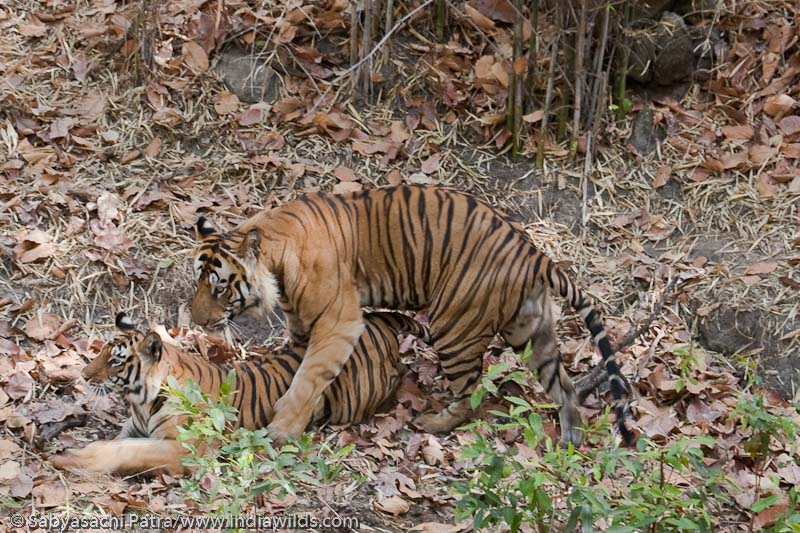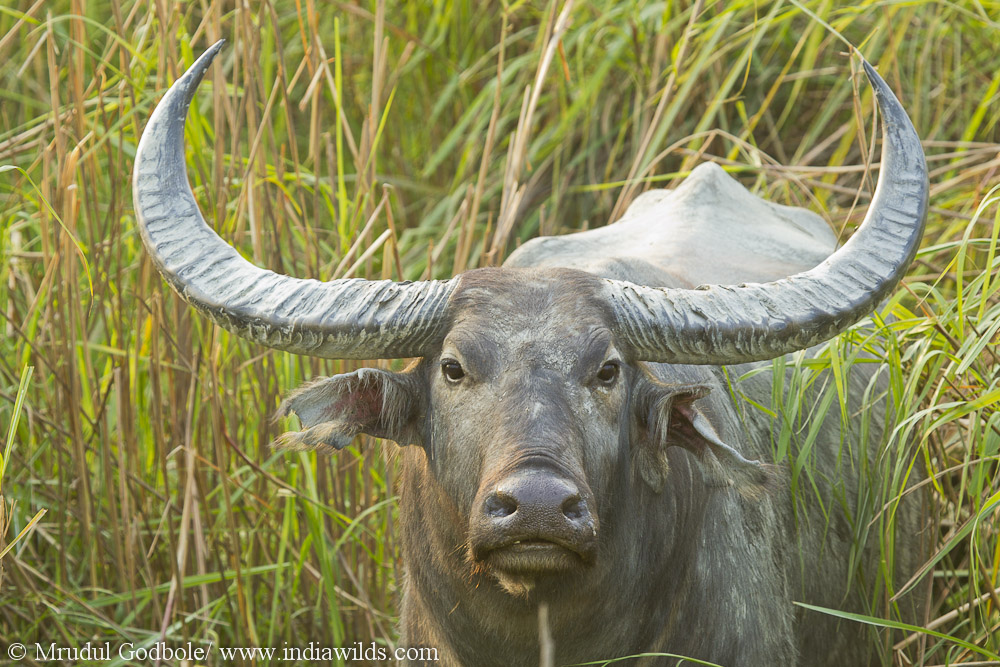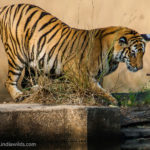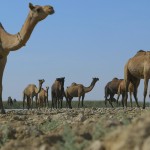IndiaWilds Newsletter Vol. 5 Issue V
Responsibility of our Popular Icons
A popular teen-flick featuring chocolate hero Tobey Maguire had a memorable dialogue “With great power comes great responsibility”. This oft quoted dialogue need not be trashed just because it was popularised by a hollywood film, as this idea probably has been around since time immemorial. A couple of centuries ago, in 1732, Voltaire had written the same wise words “with great power comes great responsibility”. These words in french are engraved in his tomb “Un gran pouvoir impose un lorde responsibilité.”
In a country like India, where we virtually deify our cinema superstars, even some fans building temples in their name, the impact of the cinema superstars are all too evident. Their smiles, antics and product endorsements are virtually flashed non-stop in TV, print, hoardings etc. Fans take great pains to speak, walk and dress up as their favourite superstars. So our cinema superstars do wield great power over their fans. Since their conduct influences millions of people, they should be conscious about their responsibility. There might be a few superstars like Shahrukh Khan who had famously said “mein bhand hoon” when he was questioned why he dances in weddings of rich people and charges them money. However, that doesn’t take away the fact that “with great power comes great responsibility”.
Recently, Ms. Aishwarya Ray Bachchan choose to dress her baby in leopard prints. http://www.hindustantimes.com/Entertainment/Fashion/Baby-B-Aaradhya-Bachchan-is-already-a-fashionista/Article1-1049619.aspx
It should be noted that animal prints came into vogue in the fashion world when a number of countries started banning use of animal skin in dresses. There are still reports of use of tiger and leopard skins in certain rituals. The revered Dalai Lama had earlier made an appeal against the use of these skins in the festivals. Till the time we continue with the animal prints in clothes, the idea that animal skins are attractive as a fashion accessory will continue. With Amitabh Bachchan keenly participating in save the tiger campaigns, his daughter-in-law should take a cue and promote conservation awareness rather than parade her kid with atavistic animal print dresses.
Preservation of our natural heritage ought to be instilled into the people from childhood days. Earlier it used to happen culturally through the various stories in Puranas, Upanishad’s etc. With the modern generation far removed from our culture which used to shape the beliefs of people, we have no way but to depend upon the public figures who take up thousands of hours of air time in TV. The actions of these people, howsoever subtle it might be, shapes our values and beliefs. Now who will teach these celebrities?
Born Free: Now behind bars
Every species have a right to live life without being subjugated by others. The laws of our society says that when a man is born free, he/she has the right to live a free life. No one can be bonded to a life of slavery. If so, is this law be applicable on other non-human species? This debate has come to the front when in a sad case a wild tiger wandered into the Nandankanan zoo on the outskirts of Bhubaneshwar, Odisha and was trapped by the authorities. This tiger was found entering into the zoo and wandering around the animal enclosures during the midnight and leaving the zoo during the early morning hours. The zoo authorities waited for the tiger to enter the zoo and when they saw it through the CC TV cameras, closed the gates to trap the tiger.
The zoo authorities are delighted to have a new tiger free of cost in their enclosure, as the story is going to attract many visitors to the zoo. To make their act look bona fide, they even say that this will improve the gene pool in the zoo as they will ensure that the wild tiger is mated with the captive tigresses inside the zoo. This makes us wonder what is the true purpose of the zoo? Is it entertainment? Is it just to make money from visitors? The zoo authorities probably can lay claim for better performance as they could successfully capture a tiger and increase the overall revenue. It pains me that very few voices are raised to ask questions whether this act is a Pro Conservation move?
It is a fact that zoos have lost their original intent of in-situ conservation. No animal has been reintroduced into the wild after raising in zoos. Why do we need to continue to capture the animals just for the hedonistic pleasure of the paying public a la roman amphitheatre?
There are a few others who want to do a detailed study as to which forest this tiger might have come from. This tiger has done nothing wrong. It’s only fault is that it perhaps couldn’t find sufficient food and/or mate for itself – as our forests are devoid of herbivores and predators- and reached Nandankanna zoo. When the tiger population in the wild is in a precarious state with very less genetic diversity, it is an unpardonable act to capture a wild tiger and keep it in the zoo.
This tiger was born free and has a right to live freely in the wild. You may kindly raise your voice to free this tiger by writing to the authorities.
Low genetic diversity in Tigers
Our forests are fragmented by roads, human settlements, canals, dams etc. With the massive increase in India’s population, the landscape has been altered drastically. During the days of the British raj when our human habitations were surrounded by wilderness areas, today the situation has been reversed. Now the wilderness areas have shrunk and look like dots encircled by human habitations. No wonder, it becomes extremely difficult for wildlife to move from one wilderness area to another. In this backdrop, a study measuring genetic diversity in the 21st century tigers and the ones during the British raj has shown up some very interesting things.
This study titled (Demographic loss, genetic structure and the conservation implications for Indian tigers – Mandal Samrat et al) http://rspb.royalsocietypublishing.org/content/280/1762/20130496.abstract has rang alarm bells. The mitochondrial DNA variants found from the tigers from British raj days were high whereas the tigers of today have about 93 percent less variants. Interestingly the study found that the tiger populations today which are isolated from each other has increased the genetic differentiation between these species. Given that most of the populations were connected roughly 50 to 100 years ago, this genetic differentiation is pretty rapid.
In a country which is fixated on the tiger numbers, debating the methodology of estimation etc, the fact that genetic diversity is getting lost due to fragmentation of our forests is not on the top of mind of our authorities. When forests are connected, tigers can move in from one forest to another to repopulate an area where the resident tiger might have died due to old age of the menace of poaching. Unfortunately, without the corridors, our wildlife can’t move from one place to another. It is perceived to be glamorous to reintroduce tigers by airlifting from one forest to another and ministers and senior officials flock to witness the event. In an era where managers and leaders need to show their performance, albeit political leaders seem to be not answerable to anybody, the attraction of quick fix solutions score over the difficult to implement long term solutions. The political community know that conservation is hard work. It needs true leadership and the requires painstaking effort. Naturally, people shy away from the long term solutions and our forests increasingly become isolated from each other.
Unless we restore the lost corridors between our wilderness areas, we seem to be presiding over the last act in the life of tiger in India’s wilderness areas.
PMO pressurised MoEF to ease coal mining rules
The present UPA Government and its head PM Manmohan Singh have been often accused of presiding over the decimation of India’s wilderness areas despite grandiose statements to the contrary. This perception is bound to accentuate further with the revealing of a letter via an RTI petition that the PMO had forced the MoEF to ease the rules to allow coal mining. A letter by Pulok Chatterjee to the Minister for MoEF Smt. Jayanthi Natarajan, dated 12th October, 2012 had asked for “doing away with the necessity of public hearings for obtaining environment clearance in cases where 25 per cent expansion is required”. Hardly a month and a half later in December 2012, MoEF did the changes as directed by PMO to do away with the requirement of public hearings for getting environmental clearances in situations where 25% expansion is needed.
In India, most of the EIA (Environment Impact Assessment) reports are shoddy to say the least. In the last few years due to the protests against such shoddy EIA reports, the industry has become worried and so are the political leaders who want to allow industries at any costs. Earlier the protests by locals against polluting industries like nuclear power in Ratnagiri and Kundakulam were mercilessly quelled. Now, in one stroke the Government has taken away even the basic right of the people to voice their protests. It is sad that the world’s largest democracy has decided to muffle the voice of its citizens.
With such actions by the Government to further fragment our forests through mining, any chance of recreating the corridors between our forested areas to help in strengthening the gene pool of our wildlife in general and tigers in particular seems like a mirage.
Terrorism & Conservation: Terrorists massacre 28 people in Chattishgarh:
In the IndiaWilds Newsletter Vol. 3 Issue II we had talked about the impact of Naxalism on Conservation: http://www.indiawilds.com/diary/indiawilds-newsletter-vol-3-issue-ii/
Unfortunately, nothing much has progressed in the last two years as far as tackling the terrorists calling themselves maoists.
In one of the shocking incidents, 28 people belonging to Congress party returning from a rally were massacred by several hundred terrorists in Bastar. The convoy of the political party was attacked by blasting IED (Improvised Explosive Devices) and were fired upon by several hundred terrorists. The security personnel guarding the leaders ran out of ammunition as they were not prepared to fight a gun battle for more than an hour. Even more shocking was the incidents, which resembled the beheading our soldiers by the Pakistani a few months back. These Maoists defiled the dead leaders by dancing over their dead bodies.
India has followed an ambivalent strategy towards these terrorists. Branded as Maoists, their acts has been described as LWE (Left Wing Extremism). Many intellectuals try to justify these acts as the act of someone who has been deprived of governance and due to lack of development. Naxalism which had started with an ideology, has now degenerated to extortion, drug trafficking and poaching and smuggling wildlife skins and articles. More than 13 percent districts in India are hit by the menace of Left Wing Terrorism. The corporates operating in these areas pay ransom to these Maoists. The Government is loathe to declare that it doesn’t have control over 83 districts as these terrorists employ guerrilla warfare and strike at their own will. Without adequate knowledge of the jungle many police and CRPF jawans have lost their lives. The Government on the other hand doesn’t want to use the helicopters to fire upon these people, as it is sitting on an idealistic notion that these are our people. Even the Chattishgarh CM said that we are not at war. Unfortunately, we have to agree that India is at war against these left wing terrorists.
For the first time, one Union Minister Shri Jairam Ramesh used the term terrorists. Else, they were always branded as Maoists. The Government has to wake up, drop its ambivalence and take strong measures to quell the terrorists and restart development projects to bring governance to these areas.
Much of these areas contain some of our dense forests. Unfortunately, due to these terrorism these areas are now out of bounds for us. The forest officials are routinely kidnapped and are often killed. Researchers, filmmakers, naturalists, in short anyone who wants to venture into these areas face the wrath of these terrorists. As a consequence, the wildlife populations or whatever has remained now is not known. So any news of sighting of an endangered species is a welcome news.
Endangered Wild Buffalo herd spotted in Indravati
In a piece of good news emanating from the terrorist infested Bastar region, two herds of Wild Buffalo – Bubalus arnee – were spotted in the Indravati National Park in Chattishgarh. This raises hope for the conservation of this species. There are plans of relocating a female from this herd to Udanti Wildlife Sanctuary. The population of wild buffaloes in Udanti is limited to nine individuals with their genetic purity questionable. The male to female ratio as well as demographic characteristics of the herds in Indravati should be properly ascertained before translocation to Udanti.
http://www.indiawilds.com/forums/showthread.php?t=12608
Indian Elephant and Dolphin most likely to go extinct:
According to a Zoological Society of London classification of top 100 mammals facing extinction threat, the elephant comes at number seventeen and the dolphin at sixty. Poaching and habitat destruction has come across as major factors for the rapidly dwindling populations of these species.
Most of our forests are ravaged by mindless mining with the Government opening up more and more forests for mining every day. Coupled with the Left wing terrorists, the mining has ensured that there is no place for our elephants. Tuskers are killed for their tusks. Others are pushed away from their homes. It is indeed a curse to be born as an elephant in today’s world.
Most of our rivers have turned into gutters due to unrestrained discharge of industrial effluents as well as sewage. Our rivers do have a natural ability to heal. However the rivers need a long stretch of about 40 kilometers to handle the pollution. Unfortunately, due to human population explosion, there is not a single kilometre in the river banks which doesn’t have human population. These polluted waters severely restrict the areas where dolphins can live.
http://www.indiawilds.com/forums/showthread.php?t=12590
Wild India – Love in the Wild:
The happenings in the past few months is deeply disturbing. The violations of women and children, systematically hunted by pack of maniacs raises several questions for which I find no answer. The Hon’ble High Court of Delhi has said that behaviour of police in trying to suppress the information of such crimes coming to light and beating up innocent protesters is worse than animals.
Earlier, Amitabh Bachchan, megastar of Indian Cinema, had said in twitter “Wanted to say so much of the day.. but so disturbed by the gang rape case in Delhi.. atrocious and unforgivable!!… The fear of system, of order, of conduct guided by justice, is fast disappearing. Is this the freedom that our elders fought for!! “On this public platform I dare not even attempt to mention the details of the rape case… even an animal would not behave so,”
This repeated assertion by people indicates that animals are worse than humans. However, one can find unalloyed joy by watching the true love and affection displayed by the animals. This short film explores the bonding between mother and child from the various wilderness areas in India. It includes Wild Ass, Wild buffalo, rhino, elephant and gaur calf suckling from mother.
http://www.indiawilds.com/diary/wild-india-love-in-the-wild/
Other Conservation News:
FAO’s solution for hunger: eat insects:
United Nation’s The Food and Agricultural Organisation (FAO) believes the solution for tackling hunger around the world is simple. Eat insects is its prescription. Instead of trying to reduce the tremendous amount of waste of food grains (Yes we produce more than our requirements), the FAO suggests people to eat insects.
http://www.indiawilds.com/forums/showthread.php?t=12553
To Bat: Or Not
Meghalaya Governor advocates eating bats:
We have enough examples of responsible people behaving in an irresponsible manner. Now, to add to that list, the Governor of Meghalaya Hon’ble Ranjit Shekhar Mooshahaary has advised people to eat bats.
 He said that bat meat is tasty and healthy.
He said that bat meat is tasty and healthy.
“The caves of Meghalaya have bats that can yield healthy meat rich in proteins,” Mooshahary said while releasing adventurist Bryan Daly Kharpran’s book Caves for the Uninitiated in Shillong on Monday.
He further went on to advise the state government to go for bat-breeding, citing the United Nations’ call for eating nutritious insects to justify bat meat consumption and in the process made some outrageous claims. “Bats eat only flowers and their meat is clean and delicious,” Mooshahary said.
Animal rights activists panned the governor for getting his facts wrong and trying to promote an “illegal” meat industry. “Bats also eat mosquitoes and other insects, besides fish, frogs, lizards and birds,” Sangeeta Goswami of People for Animals said. “But more importantly, bats are categorised as wild animals and breeding or eating them are punishable under Sections 9 and 39 of Wildlife Protection Act, 1972.”
“Besides, bat meat is not a notified food item,” Goswami said, adding that encouraging people to eat ecologically sensitive bats useful for humans in plant pollination and pest control was not becoming of a governor.
Bat meat is not popular among the tribes of the North-east although they eat a variety of animals, reptiles, birds and insects. Bat meat is a craze in South-east Asian countries such as Indonesia. People there believe the bile of bats — the giant fruit bats in particular — cures asthma and other respiratory diseases.
India has 117 of the 1,116 species of bats (Chiroptera) identified so far across the globe. More than a quarter of these are found in caves in the North-east. Meghalaya is often referred to as India’s “cave capital” with 1,350 caves identified and 850 explored so far.
http://www.indiawilds.com/forums/showthread.php?t=12594
In sharp contrast comes the welcome news that the Maharashtra Government has sanctioned two conservation projects dedicated for bats and has allocated rupees three lakh each.
http://www.indiawilds.com/forums/showthread.php?t=12585
Malabar Civet may have become Extinct:
The Zoological Society of London has said that the population of Malabar civet is unknown and it may have become extinct due to habitat loss.
http://www.indiawilds.com/forums/showthread.php?t=12577
Natural History:
Country Notebook: Google eyes – M Krishnan
http://www.indiawilds.com/forums/showpost.php?p=60840&postcount=56
Lesson to sub-adult tiger by mother – Debasis Bose
http://www.indiawilds.com/forums/showthread.php?t=12600
Image of the Month:
The honour for the Image of the Month goes to Anshul Jain’s image of Nilgai running.
http://www.indiawilds.com/forums/showthread.php?p=61157
Wildlife Photography:
Rhino by Mrudul Godbole
http://www.indiawilds.com/forums/showthread.php?t=12402
Marmot by Gajanan Bapat
http://www.indiawilds.com/forums/showthread.php?t=12445
Flying Blackbuck by Keerthy Rajagopal
http://www.indiawilds.com/forums/showthread.php?t=12511
Macchli by Vijay Rajan
http://www.indiawilds.com/forums/showthread.php?t=12412
Leopard Sprint at Kabini by Bhargava Srivari
http://www.indiawilds.com/forums/showthread.php?t=12396
Goose Barnacle by Abhishek Jamalabad
http://www.indiawilds.com/forums/showthread.php?t=12414
Himalayan Morning by Kaustuv Chatterjee
http://www.indiawilds.com/forums/showthread.php?t=12468
Srilankan Frogmouth by Bibhav Behera
http://www.indiawilds.com/forums/showthread.php?t=12513
Yellow wattled lapwing by Jitendra Katre
http://www.indiawilds.com/forums/showthread.php?t=12487
Painted Sandgrouse Female by Hymakar Valuru
http://www.indiawilds.com/forums/showthread.php?t=12522
Scaly breasted Munia with a compact camera by Partha Pratim Patra
http://www.indiawilds.com/forums/showthread.php?t=12435
Equipment Discussions
Canon EF 200-400 f4 L IS USM lens shipping:
http://www.indiawilds.com/forums/showthread.php?t=12556
Who’s Who:
Check out our Who’s Who section. If you haven’t introduced yourself, then you can introduce yourself with a brief description, image and your work. This will help in many fellow members and readers to interact and collaborate on assignments.
http://www.indiawilds.com/forums/forumdisplay.php?f=22
I look forward to your inputs and support in preserving the last tracts of wilderness and wildlife left in our beautiful country. For other interesting articles and images check – http://www.indiawilds.com/forums/
To post in the IndiaWilds forums, you can register free of cost using your Full Name as user id at http://www.indiawilds.com/forums/register.php
If you are already a member of IndiaWilds and have forgotten you user id and/or password you can mail to administrator@indiawilds.com
If you want to contribute original articles, then please send a mail to administrator@indiawilds.com
Regards,
Sabyasachi Patra
Profile: http://www.indiawilds.com/about.htm
Contact: http://www.indiawilds.com/contact_us.php
Facebook: http://www.facebook.com/pages/IndiaWilds/132629240481
Diary: http://www.indiawilds.com/diary/
Equipment reviews: http://www.indiawilds.com/diary/category/equipment/
Forums: http://www.indiawilds.com/forums/index.php
IndiaWilds Channel: http://www.youtube.com/indiawilds
Please post your views and feedback in the comments below.
- GoPro Hero 12 Black - 6 September,2023
- Leopards: The Last Stand - 2 July,2023
- Drifting in the Waters of Sundarbans - 26 March,2023














Hello Sabyasachi,
Many times I’ve attempted to post a comment but it doesn’t get published. let’s see if I succeed today.
This news letter is so comprehensive that I’ll visit again to read it thoroughly.However your passion for the preservation of our precious wild is visible in your lucid articulation. Your account is so expressive and genuine as to impact the reader deeply. Wishing you all success in your ventures!
I am very happy that you like my effort. Thanks a lot for your words of encouragement.
Whenever someone comments, it immediately goes into moderation. Later on, I physically approve the comments. This is to stop the close to hundred spam comments that I get everyday. Your comments are highly valued.
Cheers,
Sabyasachi
Indian elephant and dolphin becoming extinct. That day will be worst day.
I fully agree with you. Apart from its conservation significance, animals like elephants are interlinked with our cultural heritage. It would be a sad day indeed and this warning should be treated as a huge warning for our survival as well. Afterall, man cannot live in isolation in a world increasingly ravaged by climate change.